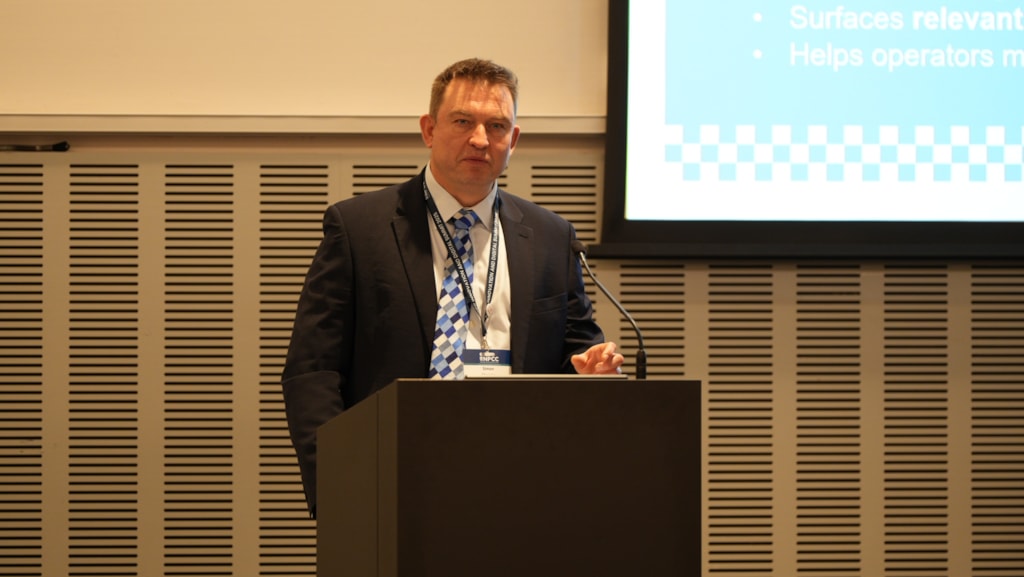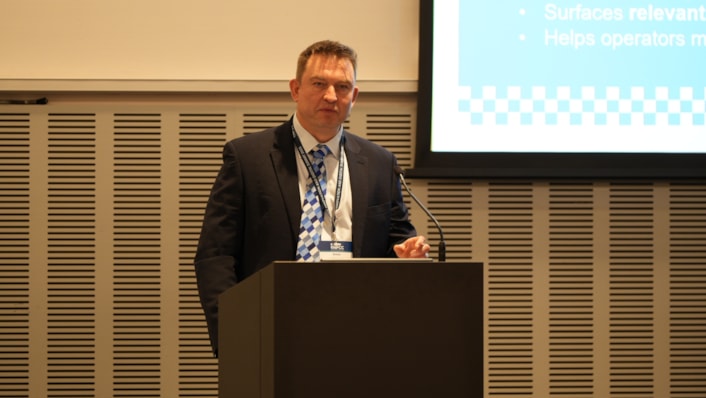
27 Oct 2025
Transforming public contact in policing
Chief Constable Simon Megicks outlines the full capabilities of the Digital Public Contact programme
Chief Constable Simon Megicks, NPCC Lead for Public Contact and Senior Responsible Owner for Digital Public Contact, joined senior policing, government and industry figures at the NPCC Innovation and Digital Summit 2025 last Tuesday (21 October).
Over three days, more than 800 delegates came together to explore the future of policing, with a focus on how better collaboration and smarter use of technology can transform public service.
A key moment came from Sir Brian Leveson, who powerfully highlighted how fragmented and inconsistent IT systems across policing are undermining the wider criminal justice system. His call for a nationally consistent approach to technology set the tone for the summit – underscoring the urgent need for joined-up solutions that improve efficiency, accountability and public trust.
Following this powerful message, Chief Constable Megicks took to the stage to share how Digital Public Contact (DPC) is driving transformation across policing.
---
Good afternoon, everyone.
I’m Simon Megicks, Chief Constable of Cambridgeshire Constabulary - a role I’m incredibly proud to hold. But today, I’m here wearing a different hat: as the NPCC Lead for Public Contact and SRO of Digital Public Contact.
Many of you will be familiar with Single Online Home (SOH), which recently passed the milestone of 10 million non-emergency contacts; a testament to its success and impact. But today’s conversation goes beyond SOH.
DPC is much more than a single platform. It’s a national capability delivering a suite of live, proven tools that are already transforming how policing connects with the public – cutting through fragmentation, improving consistency, and driving better outcomes across the board.
So today, we’re going to be talking about:
- How we’re flipping the script on public contact with National My Police Portal
- How we’re speeding up justice with Rapid Video Response.
- How we’re showing up where young people are online, engaging with them directly, and owning the digital frontline.
- And how we’re leading the AI charge – triaging calls, surfacing insights, backing up operators in real time.
This morning, we heard Sir Brian Leveson speak powerfully about fragmentation and inconsistencies between systems – and how these issues ripple across the wider criminal justice system. We also heard about the benefits that come from a consistent, joined-up approach. That message leads perfectly into what I want to share with you next.
DPC has developed a toolkit of live, proven products – tools that are already in use and already making a difference. They’re built to cut through fragmentation, bring systems together, and deliver the kind of consistency we know is critical to improving outcomes across policing.
Now, who here has had a full customer service journey handled entirely through text updates? Maybe via WhatsApp, or a dedicated app?
For the less critical stuff in life, who wants to sit on hold for 15 minutes just to get 60 seconds of information? We don’t accept that in our day-to-day lives – so why should it be the norm in policing?
Here’s the problem we face:
- 101 handles around 20 million calls a year.
- 20% of those aren’t even policing-related.
- 40% are people chasing updates.
- Each call costs around £7-£9 to answer.
You can do the maths – it’s a huge drain on time, money, and capacity.
Enter National My Police Portal (NMPP).
People expect public services to be as seamless as their everyday digital experiences – and we’re stepping up to meet that expectation.
NMPP gives the public a single account and platform with automatic updates for all their interactions with policing. It’s a modern solution to improving how we provide case updates – and the exciting news is, we’re going even further by integrating trusted GOV.UK tools like One Login and GOV Notify, making the experience even more seamless, secure, and familiar for users. This is another step toward removing friction and fragmentation, and delivering the kind of joined-up service the public expects.
For policing, this capability reduces demand, improves compliance with the Victim Code, and saves time for both control rooms and investigators.
Later this year, South Yorkshire Police will become the first force to go live with a fully delivered, police-led national portal – a major milestone. Kent and Essex will follow, with more forces in discussion.
So far, across proof-of-concept forces, we’ve seen over 35,000 accounts created and more than half a million user journeys. In fact, in Humberside, the Inspectorate reported a 60% drop in repeat 101 calls. This is real impact – and it’s just the beginning.
We’re not just innovating in traditional contact – we’re also tackling challenges in other areas, like Rapid Video Response for domestic abuse calls.
Now, let me be clear: RVR is not a substitute for immediate dispatch. If someone is in danger or at risk, this is not the tool we use.
RVR is designed for situations where the moment of risk has passed, but there’s still a need to capture evidence, provide reassurance, and move the case forward. It’s about giving victims a faster route to speak with an officer, especially when resources are stretched, and an in-person visit might take hours.
The benefits?
- Higher completion rates for key safeguarding assessments like DASH and DARA.
- More arrests, because evidence is captured quickly.
- And better safeguarding, with faster referrals and follow-up.
One force saved £190K thanks to this capability. Scale that nationally and you’re looking at substantial savings – huge savings that also come with increased victim satisfaction, quicker safeguarding, and more offenders being held accountable.
Next, Digital Youth Engagement – or DYE.
Through the YourPolice.UK Instagram channel, we reach around 300,000 under-18s every month in the places where they’re spending most of their time – in their digital neighbourhood. The team is live 12 hours a day, 7 days a week, tackling misinformation and building trust.
We’ve had young people disclose serious concerns – things they might never have shared otherwise. These cases go straight to the Metropolitan Police contact centre for action.
And for forces without in-house creative teams? We’ve produced over 1,000 pieces of ready-to-use content, all made by our own designers and videographers – and shared freely across policing.
On the topic of social media, the DPC Social Media capability provides a national model for 24/7 digital desks by offering implementation support, and demand dashboards.
Crucially, through this framework we have given forces affordable access to social media management software – negotiated once, not 43 times.
And yes, while I love a good police dog post, effective social media is about keeping people on digital channels instead of pushing them to 101 or 999. Because when we get it right, we don’t just manage demand – we build trust, improve outcomes, and make digital the first choice, not the last resort.
Every two years, we ask the public how they want to engage with police online. Results from the latest survey show our digital desks are more modern, more efficient, and outperform traditional setups. Crucially, people trust updates from police social media and websites more than other sources. That’s a clear signal: credible, well-managed digital channels are essential in an age of misinformation.
And that’s just a snapshot of some of our products. I could say more, but before I go, I must talk about AI. We’re ahead of the curve here as well, with three major projects in play.
The first project: Natural Language Switchboard.
This tool uses AI to triage incoming calls, identifying and redirecting those that fall outside policing. A trial for this service will take place next month, and we expect to see a national rollout in December.
This isn’t just about efficiency – it’s about impact. By targeting the removal of half of the misdirected demand of 101, we’re aiming to reduce millions of unnecessary calls, freeing up resources and improving the experience for those who genuinely need police support.
The next: Past Call Analysis.
This will ensure that every call that comes in is transcribed, stored, and made searchable, creating a rich dataset that can be analysed to uncover hidden patterns, recurring issues, and connections that might otherwise have been missed.
It’s not just about looking back – it’s about learning. This capability will help forces identify emerging trends, improve service design, and support investigations by surfacing links between calls that were previously invisible.
Finally, Live Operator Assist.
This one is exciting and is currently being piloted in Humberside Police. It supports call handlers in real time, and as they converse, the AI listens in and conducts live database searches, surfacing relevant information instantly.
It then drafts THRIVE assessments on the fly, enabling faster, smarter deployment decisions. The result? Operators are empowered to make better decisions, quicker: reducing risk and improving outcomes for the public.
Individually, these tools are powerful. Together? Transformational.
So, that’s the tour. Real products. Real results, and a future already in motion.
Before I close, I want to spotlight something that often flies under the radar but is central to our mission: DPC isn’t just delivering for contact management. Increasingly, we’re enabling other NPCC portfolios with scalable, cost-effective tech – often at a fraction of commercial alternatives.
For example, we’re working with the National Centre for VAWG and Public Protection, and the Revenge Porn Helpline, to improve how victims report online intimate image abuse. It’s sensitive, complex work – and shows how DPC’s capabilities extend far beyond traditional contact.
We’ve also built a community tension dashboard to support early intervention and situational awareness, work deemed essential after last summer’s unrest and the Inspectorate’s review. It operationalises tension mapping and is set to become a core part of policing intelligence.
Another example: we’re scaling a smart workflow originally developed at Thames Valley Police to help forces meet the Neighbourhood Guarantee - responding to SOH messages within 72 hours. Requests are routed, mapped to local teams, and tracked in Power BI. It’s a practical way that we’re helping forces deliver the NPG, just as we did with the Named Contactable Officer pledge.
We’re also using AI to explore new frontiers – from analysing Body Worn Video to uncover insights that might otherwise be missed, to digitising historical police records. Commercially, that work is valued in the millions – but we believe our AI functionality can deliver it for far less.
These examples show why a national transformation capability inside local policing matters: agile, affordable, and built for public service.
So in closing, if you remember one thing, let it be this:
DPC is here to give forces more control, cut duplication, break supplier lock-in, and raise the standard of public service everywhere.
Why build the same capability 43 times when we can do it once, nationally, and share it?
This is the essence of Policing as a Platform: a shared digital foundation that enables local delivery while driving national consistency – built once, used many times, and designed around public need.
For policing, this means:
- Better, faster decisions.
- More efficient use of resources.
- Improved public protection.
For the public, it means:
- No repeating your story.
- Getting the right help, faster.
It’s about trust, accessibility, and fairness. It’s about freeing up millions so more officers can be where they’re needed most.
It’s about One Standard. One Platform. One Contact.
That’s our ambition – and we’ll get there, together.
Thank you.
Contact information
Communications office
By phone: 0800 538 5058
By email: press.office@npcc.police.uk

